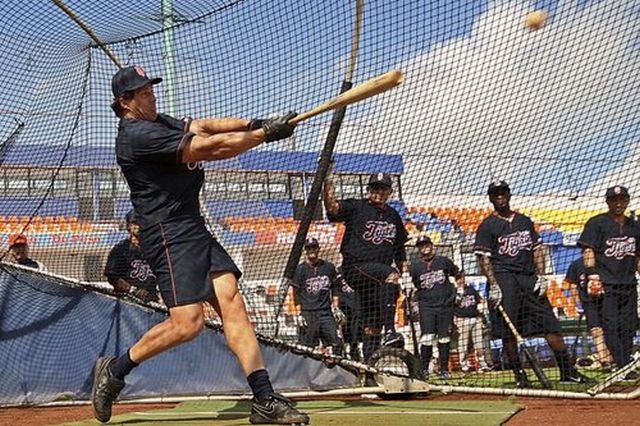
The latest debacle involving Jose Canseco has overshadowed a legitimate issue facing professional and Olympic sports – the prospect of middle-aged athletes being prescribed testosterone to combat the negative consequences arising from hypogonadism. The conversation hasn’t been about the “use of testosterone replacement therapy (TRT) in sports.” It has been about “Jose Canseco the steroid user”.
The TRT issue has been summarily dismissed by practically every sportswriter who has covered Canseco’s attempted comeback to Major League Baseball via the Mexican Baseball League.
Canseco reportedly was on the verge of being signed by the “Tigres de Quintana Roo” of Cancun until he revealed that he was using testosterone cypionate and human chorionic gonadotropin (hCG) as part of a testosterone replacement therapy (TRT) protocol.
Cuauhtémoc Rodríguez Meza, the CEO of the Tigres, told ESPN Deportes that he was aware that Canseco was on TRT and welcomed his return to the team once he could justify his use of testosterone for therapeutic reasons.
But the mainstream media in the United States characterized the Canseco story as one of a former steroid user busted for doping once again. “Once a steroid user always a steroid user” was the general gist of the headlines. Few sportswriters were willing to recognize the possibility that Canseco may actually have a legitimate requirement for TRT.
Even Canseco’s ghostwriter for his book “Juiced” mercilessly attacked Canseco over the latest steroid escapade. You would think that if there was anyone in the world who would give Canseco the benefit of a doubt and believe his TRT story, it would have been Steve Kettman.
“Jose Canseco… is still apparently juicing like mad to try to keep himself jacked up enough to swing and miss with regularity down in the Mexican League,” Kettman wrote in an essay on Huffington Post. “Or was until he got busted.”
Canseco has posted prolifically on Twitter using the social media platform to defend himself against doping accusations.
“I just want to play baseball. It’s real simple. I don’t want to use steroids,” according to Canseco. “They put me on testosterone therapy because medically I need it. I can’t live without it. Believe me I don’t want to do it.”
Canseco has suggested that Paul Budnick, M.D., founder and medical director of the Anti-Aging Institute of Arizona, has been the physician treating him for hypogonadism for the past few years. He provided a note from Dr. Budnick that gave Canseco his authorization to “travel with needles & syringes for medication prescribed by medical doctor. Testosterone Cyp / HCG”.
The fact that Canseco is on TRT should come as no surprise. His problems with low testosterone and low libido resulting from anabolic steroid induced hypogonadism (ASIH) were painfully documented in the documentary “Jose Canseco: The Last Shot” that was broadcast on the A&E cable network in October 2008.
Low testosterone is a problem that faces millions of American middle-aged men even when they have no history of prior steroid use.
Of course, Canseco reportedly used anabolic steroids for 24 years. The severity of the hypogonadism was likely compounded by Canseco’s long-term steroid use.
The Canseco TRT issue raises important questions for middle-aged athletes competing in drug-tested sports.
Should they be permitted to use banned performance-enhancing drugs if they have a medical diagnosis which indicates their use?
Contrary to what many people seem to think, most drug-tested sports do allow athletes to use anabolic steroids if they qualify for a therapeutic use exemption (TUE). The World Anti-Doping Agency (WADA) and Major League Baseball (MLB) both have procedures in place for athletes to request permission to use steroids when medically indicated.
The Independent Program Administrator of MLB’s Joint Drug Prevention and Treatment Program is responsible for reviewing an athlete’s medical records and determining whether the otherwise banned performance-enhancing drug is medically necessary.
And MLB has allowed a few players to use injectable and/or topical testosterone as a treatment for hypogonadism.
Three MLB players were given the green flag to “dope” with testosterone in 2008 and one player was permitted to use the steroid in 2009.
The real questions surrounding the Jose Canseco – steroid controversy involve why Canseco did not seek a therapeutic use exemption.
What steps are required by Canseco to justify his use of steroids?
What is the process by which an athlete obtains a TUE in the Mexican Baseball League?
Are athletes required to follow the TUE process specified by the Joint Drug Prevention and Treatment Program since the Mexican Baseball League is a triple-A league sanctioned by Minor League Baseball (MiLB)?
Or are athletes in the Mexican Baseball League required to follow the anti-doping rules established by Mexico’s National Commission for Physical Culture and Sport (CONADE)?
Of course, sports writers aren’t interested in asking the real questions. They would rather jump on the anti-steroid bandwagon and lash out at the man who personifies the evils of baseball’s steroid era.

About the author
Millard writes about anabolic steroids and performance enhancing drugs and their use and impact in sport and society. He discusses the medical and non-medical uses of anabolic-androgenic steroids while advocating a harm reduction approach to steroid education.

Leave a Reply
You must be logged in to post a comment.